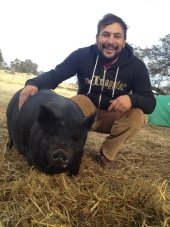I really love this thread and would like to keep it alive with my own experience. Here at Dragon Hour Farm & Ferment we have raised Mangalitsas, American Guinea Hogs, and Berkshires all raised on rotated pasture (thanks in part to the wonderful knowledge on these forums) -- each breed we fed prodigious amounts of acorns to finish in the last 3 months, along with cherries, kale, whey, and spent barley from the local brewery. The pork from the berkshires was good, but the mangalitsas and guinea hogs were the finest I've ever eaten, and have made me an obsessed pig farmer. I am consistently amazed at the differences in genetics of these breeds...especially between the lard pigs vs. the berkshires. The mangalitsas and guinea hogs were far superior in flavor, especially when we cured the meat using traditional charcuterie methods. The fat is really the difference...
I've also eaten Jamon Iberico de Belotta and love it dearly. But personally, I believe that a well-raised Mangalitsa or American Guinea Hog, raised on pasture finished on lots of fruits, nuts, whey, and greens, can be just as good if not superior to Jamon Iberico de Belotta. I'm just a beginner, and wholeheartedly think mine were better than those Ibericos I've eaten. I fully encourage you to keep on with your enthusiasm and your experiment. Greatness need not bound in by mere appellation.
Moving forward, the one thing I will do different is start cross breeding the mangalitsas and guinea hogs with eachother and other heritage breeds. In my experience, the mangalitsas do take significantly longer to get to maturity, about a year and a half, and the guinea hogs are simply less meat -- they are small! But both those breeds have such wonderful fat...and temperments. The berkshires just got to market weight so freaking fast -- 5-6 months! So many possibilities. So much pork to eat!




